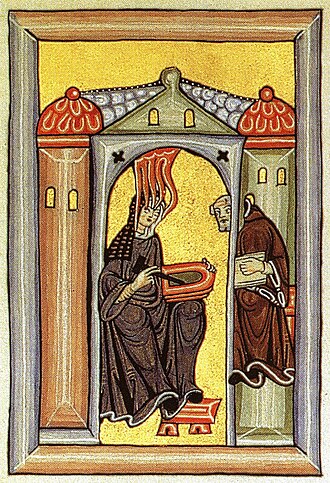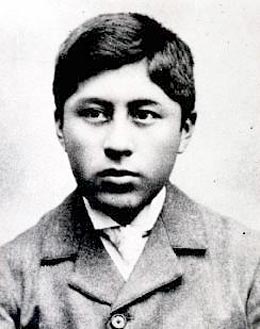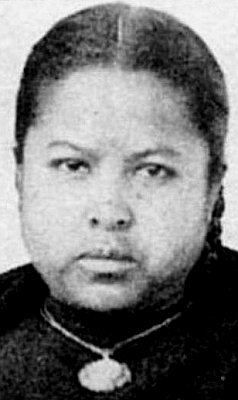And yet... Without diversity in the genome there is nothing for natural selection to chew on. It is the material cause of evolution. Diversity enters too between kinds of things: the same outlet that offers the Big Mac also offers chicken breast sandwiches, cheeseburgers, nuggets, and a diversity of other kinds. And if diversity within a species is iffy, diversity between species is another matter. Aquinas held that the multiplication of species across time and geography was a way in which creation participated in the infinity of the Creator.
Today being Pentecost, we celebrate the single most diverse assemblage on Earth: the Communion of Saints. It includes peasants [St. Joan of Arc] and emperors and empresses [Sts. Heinrich II and Kunigunde]. They are 12 years old [Maria Goretti] and 86 [Polycarp of Smyrna]. They have included schoolteachers [Jean Baptiste de la Salle] and highwaymen [Moses the Black]. They have been martyrs [Habib the Martyr], musicians [Ephraem of Syria], and mystics [Hildegarde of Bingen]. They have come from every people on the face of the earth. Naturally, this Church must be celebrated by the champions of diversity....
In addition to the big names, a sampling in time and space:
| Habib |
Syrians: Habib the Martyr, John of Damascus, Pope John V
Lebanese: Nimatullah Kassab Al-Hardin, Rafka al Rayes, Sharbel Makluf
Anatolians: Nicholas, Gregory Nazianzen, Macrina the Younger
Greeks: Irene, Athanasia of Aegina, Alexander Akimetes
Romans: Agnes, Cecilia, Pope Cornelius
North African: Augustine of Hippo, Perpetua and Felicity, Cyprian of Carthage
Egyptians: Anthony the Hermit, Mary of Egypt, John the Merciful, Catherine of Alexandria
Arabs: Moses the Arab, Cosmas and Damian, Sheikh Aretas of the Banu Harith and the Martyrs of Najran, Mary Baouardy, the Little Sister to Everyone
Assyrians/Iraqis: Thaddeus and Maris, Maruthas of Maiferkat, Ephraem, the Harp of the Holy Ghost
Persians: Anastasius Majundat, Abdon and Sennen
Ethiopians: Iphegenia of Ethiopia, Kaleb Elesbaan of Axum, Moses the Black
Armenians: Isaac the Great, Gomidas Keumerigian
 |
| The Little Flower |
Italians: Thomas Aquinas, the “Dumb Ox,” Clare of Assisi, John Bosco, Pope John XXIII
Spaniards: Nathalia and Aurelius, Theresa of Avila, Bonifacia Rodríguez de Castro
Basques: Ignatius Loyola
Portuguese: Anthony of Padua, Isabella
French: Jane Frances de Chantal, Margaret Mary Alacoque of the Sacred Heart, Theresa of Lisieux, the Little Flower
Bretons: Alan de Solminihac
Belgians: Mary of Oignies
Irish: Brigit of Kildare, Columba, Colmcille of Iona, etc.
Scots: David, King of Scots, Margaret of Scotland
English: Margaret Clitherow, the Pearl of York, Thomas More
 |
| Hildegarde of Bingen |
Germans: Gertrude of Helfta, Herman the Cripple, Hildegarde of Bingen, the Sybil of the Rhine
Austrians/Swiss: Nicholas von Flue, Jakob Gapp
Scandinavians: Willehad of Denmark, Hallvard of Oslo, Bridget of Sweden, Thorlak Thorhallsson of Iceland
Balts: George Matulaitis
Magyars: King Istvan the Great, Elizabeth of Hungary
Czechs: Good King Wenceslaus, Agnes of Bohemia
Poles: Hyacinth Ronzki, Stanislaus Szczepanowski, Mother Mary Theresa Ledochowska, Pope John Paul the Great
Albanians: Mother Theresa of Calcutta
Slovenes: Lojze Grozde
Serbs: Sava
 |
| Kateri Tekakwitha |
Romanians: Ieremia Stoica
Bulgars: Bishop Eugene Bossilkov
Russians: Olga of Kiev, Sergius of Radonezh, Euphrosyne of Polotsk
Native Americans: Kateri Tekakwitha, the Lily of the Mohawks, Black Elk of the Oglala, Juan Diego Cuauhtlatoatzin of Guadeloupe
Puerto Ricans: Carlos Manuel Rodríguez Santiago
Mexicans: María Guadalupe García Zavala, “Mother Lupita”, Bartholomew Laurel, Padre Pio
Central Americans: Peter Betancurt of Guatemala, Bishop Oscar Romero of El Salvador
Peruvians: Rose of Lima, Ana de los Angeles Monteagudo
Ecuadorians: Mercedes of Jesus, Mariana de Paredes, the Lily of Quito
Brazilians: Pauline of the Agonizing Heart of Jesus, Antonio de Santa Ana Galvao
 |
| Ceferino Namuncurá |
Argentinians: Ceferino Namuncurá, the Lily of Patagonia
Chileans: Teresa of the Andes, Alberto Hurtado Cruchaga
Americans [USA]: John Nepomucene Neumann, Elizabeth Seton, Katherine Drexel, Mother Frances Cabrini
Canadians: Marguerite D’Youville, Mary Rose Durocher
Indians: Alphonsa Mattahupadathus, Kuriakose Chavara, Mother Mariam Thresia Chiramel Mankidiyan
Chinese: Thaddeus Lieu, Agnes Sao Kuy
Japanese: Father Thomas Hioji Rokuzayemon Nishi, Magdalene of Nagasaki
Koreans: Agatha Kim, Paul Chong Hasang
Thais: Philip Siphong, Sister Lucy Khambong
 |
| Victoria Rasoamanarivo |
Filipinos: Lorenzo Ruiz
Australians: Mary of the Cross
African diaspora: Benedict the Moor, Martin de Pores
African: Charles Lwanga of Uganda, Mother Josephine Bakhita of the Sudan, Anwarite Nengapeta of the Congo
Victoria Rasoamanarivo of Madagascar
A: Jesus said, “Go, therefore, and make disciples of all nations, teaching them all that I have commanded you.”
℟: And there before me was a great multitude which no one could count, from every nation, race, people, and tongue, standing before the throne and before the Lamb.



Awesome list!
ReplyDeletePsst: found 2 typos: Edith Stern and Miguel Pio
Fixed
DeleteHey, St. Raymond of Penyafort was almost a hundred years old, and there was another one whose name I forget who passed a hundred (an Englishman, I think, in the days of the Heptarchy). St. Polycarp was particularly feisty, though, for eighty-six.
ReplyDeleteDon't forget St. Anthony the Abbot, died at 105.
DeleteWell, I wasn't actually trying to find the very oldest or youngest; just trying to indicate the range.
Deleteawesome. the RCC is probably the MOST diverse institution that's ever existed.
ReplyDeleteUnquestionably so. It is an institution that claims both Viennese intellectuals and Amazonian hunter-gatherers as members in equal standing.
DeleteSt. Anthony! How could I forget him?
ReplyDeleteI guess he got
Delete( •_•)
( •_•)>⌐■-■
lost?
(⌐■_■)
YYYYYYYEEEEEAAAAAAAAAAHHHHHHHHHHHH
(For those who have not previously encountered this meme.)
Cuauhtlatoatzin, St. Juan Diego's Nahuatl name, is often translated "Eagle Voice" but it actually means "Eagle Lord". Cuauh(tli) means "eagle", Tlatoa(ni) literally means "speaker" (hence the "voice" translation) but idiomatically was the title of the dictators of Nahuatl city-states, and -tzin is an honorific without an actual definition, something like -san in Japanese. Or rather like -sama in Japanese, since -tzin tends to imply more deference than -san does. (Although, like the Kyoto dialect's use of -san, -tzin can be applied to some inanimates—places in Kyoto, abstract concepts in Nahuatl. E.g. īyeliztzin in Dios, "nature of God"—the first word, "(his/her/its) nature", is īyeliztli without the -tzin.)
ReplyDelete*Īyeliz, rather; in the possessed case it loses the absolutive suffice -tli.
DeleteSt. Abo of Tiflis says hello! *splashes you with perfume*
ReplyDeleteAnd a Palestinian, St Silvanus/"Silouane" as often referred to of Gaza.
ReplyDeleteThis comment has been removed by a blog administrator.
ReplyDelete